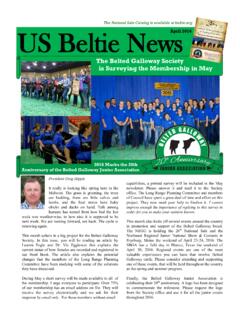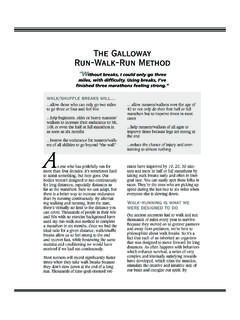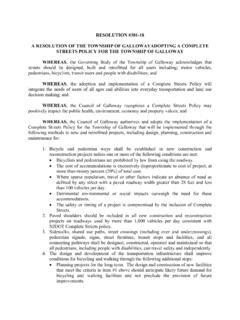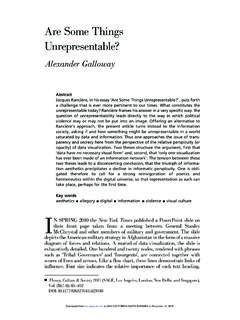Transcription of www.beltie.org The Belted Galloway Journal 2016 – 1
1 The Belted Galloway Journal 2016 1 The Belted Galloway Journal 2016 3 2016 Officers & cOuncilPresidentGreg HippleSutliff Belties 5425 Sutliff Rd NE Solon, IA 52333 Vice PresidentLisa LovettAntietam Farm 5600 S. Hickory Rd. Oregon, IL 61061 Past PresidentMichelle OgleSouthdown Farm 818 Burnt Mills Rd. Bedminster, NJ 07921 Executive DirectorVictor Eggleston, DVMHav-a-Belt Galloways N8603 Zentner Rd New Glarus, WI 53574 fax US Beltie NewsLeanne FogleWayside Valley Farm 1496 County Road 125N Congerville, IL 61729 Jon BednarskiSherwood Acres, LLC 3001 Ballard School Rd Lagrange, KY 40031 HemmerWhite Sulphur Farm 3645 White Sulphur Rd Gainesville, GA 30507 CrittendenSailin C Ranch 1070 South Hoytsville Rd Hoytsville, UT 84017 Dawson MastersDouble M Ranch 173 HCR 3303W Malone, TX 76660 972-465-0339 TrippMagnolia Trace Farms 3037 Melvin Mason Rd SE Brookhaven, MS 39601 photo credits: Messmer-Izing Farms; E8516B Quarry Rd; Rock Springs WI 53961 The Belted Galloway Journal is published for:The Belted Galloway Society, Zenter Rd.
2 New Glarus, WI 53574 Phone: Fax: by: Connections Advertising and Marketing153 Beverly Avenue Lexington, KY Debby NicholsEditor: Leanne Fogle/Rachel MooreContent Coordinator: Jon BednarskiAdvertising Sales: Debby Nichols/Carol RamseyGraphics/Designer: Sandy McCartPresident s Letter ..4 Society Sponsored Sales ..9 Jane Faul Service Award ..112015 Show Point Awards ..13 Belted Galloway Jr. Association ..16 Calendar of Events ..22 Chatfield Memorial Scholarship ..24 Journal Report ..26 Regional Groups ..28 Canadian Livestock Records ..29 Harry T. Burn Award ..30 Listing of Advertisers ..34 The Abbey of Regina Laudis 19 Ray Family Farms 62016 FEATURES The Belted Galloway Journal 2016 19 Feature By Kara KeetonAs visitors approach the Abbey of Regina Laudis in Bethlehem, Connecticut they can sometimes catch a glimpse of black cows with a white belt grazing in the green pastures.
3 I guess it is fitting that we have mainly black cows with a white belt; we do wear black and white habits, laughed Sister Augusta Collins, the manager of the beef herd. The Abbey of Regina Laudis has two Belted breeds on the farm, Belted Galloway and Dutch Belted , but Sister Augusta points out the white belt is the only thing they have in common. A Breed of StewardshipThe docile black cows with the unique white belt were not the first beef breed to graze the fields of the Abbey. When Mother Stephen introduced cattle to the agriculture operation in the 1960s she began with Shorthorn cattle and through the years interbred with Angus, Charolais and Simmental. I became in charge of the hay, pastures, and beef herd when Mother Stephen became ill. At that time we had a mixed breed of cattle, said Sister Augusta.
4 We conferred and decided to get back to a single breed. Sister Augusta talked about researching breeds that would be suited for the weather and lands. The sisters first had considered Galloway , but when offered a donation of a Belted Galloway bull and a heifer they happily accepted. Mother Dolores uncle and aunt raised Belted Galloway Belted Galloway cattle at the Abbey of Regina Laudisin Michigan, and they offered to give us a bull and a heifer, explained Sister Augusta. That is when we started our Belted Galloway herd. Sister Augusta laughed as she told the story of when she and Mother Telchilde drove from the Abbey to Gobles, Michigan to pick up the new bull and heifer from Vance and Gladys Kincaid. The journey in 2000 was not only the beginning of the Belted Galloway herd at the abbey, but the beginning of a new method of raising beef on the farm.
5 Adding the Belted Galloway breed to their cattle herd has allowed the sisters to transition their farming operation to one with a greater focus on conservation and stewardship practices in the field. Originally we raised corn for silage along with hay, but they found Belted Galloway were such good grazers there wasn t a need to raise silage. When you plow the land it is a lot of work and you are also diminishing the organic matter in the soil, stated Sister Augusta. Belted Galloways are a very healthy good grazing breed. If you cultivate healthy pastures, you can just point them in the right direction and they are very self-reliant. Today their herd is grass-fed and supplemented with hay in the winter months. By focusing on grazing lands and raising hay the sisters are able to maintain and improve the land while not taking on the additional work required with the production of silage.
6 The sisters have been able to improve grazing with Ascontinued page 2020 - The Belted Galloway Journal 2016 assistance from the NRCS, by receiving funding for fencing and other projects on the farm. We have over 100 acres in pasture today that we rotationally graze and cut for hay, said Sister Augusta. We have also started grazing after the second cutting on some of our hay fields, which helps improve the land. She explained that the abbey has taken advantage of several Natural Resource and Conservation Service (NRCS) programs that have been offered over the years to help farmers implement conservation practices on the farm. We have always had a focus on conservation and in the 1990s we received a River Restoration grant that allowed us the Abbey of Regina Laudisto protect an area of wetlands on the farm with high tensile fencing.
7 We were also able to use grant funds at that time to create two cattle crossings so the cattle would not go through the wetlands and streams to get to the pastures. Recently they received an EQIP grant to build a new bull barn in a heavy use area. The funds allowed them to take down an old barn, build the new small structure, and put in place a conservation plan to reduce runoff during the rainy and winter months for the heavy use area. It is a small beautiful structure that has helped to improve our operation and the land, since we have to keep animals in the barn at times during the winter, said Sister Augusta. We have a wetland downhill from the heavy use area, and the new barn has been a huge help in conservation efforts. The abbey is very excited to see all the changes implemented on the farm thanks to these conservation programs.
8 They hope to implement the final phase of the rotational grazing plan this fall with the addition of field watering systems, as they continue to strive to develop the optimal rotational grazing plan for their operation. The rotational grazing will allow us to manage the pastures and hay fields for our herd of 14 breeding animals, the new Belted Galloway bull we purchased last year, steers being raised for beef, and the 10 new gorgeous calves, said Sister Augusta. We will continue to breed animals for use at the Abbey and to sell, but we have no plans of expanding our from page 19 The Belted Galloway Journal 2016 21 operation. We plan to remain a sustainable grass-fed operation and are comfortable with our current numbers. Expanding too much would mean moving into a direction where the animals would be more confined due to increasing Faith of StewardshipThe Belted Galloway herd is just one part of the rich agricultural tradition the small monastic community has embraced in their stewardship efforts since Mother Benedict founded the abbey in 1946.
9 Mother Benedict, born Vera Duss, was a United States citizen by birth but lived most of her early life in France with her mother. She became a surgeon after receiving her Doctorate in Medicine from the Sorbonne. She left that behind in 1936 when she heard the Lord s calling and entered the Benedictine Abbey of Notre Dame de Jouarre. During World War II, Jouarre and the Abbey were occupied by the Germans. As an American, Mother Benedict spent the war in hiding. As she watched the American soldiers liberate the village and abbey, she decided it was her calling to give something back to her home country. Mother Benedict decided she would give back by establishing a monastic foundation in the United States, explained Sister Augusta. She had originally planned to establish a monastery in Virginia, but she was shown hospitality by an artist in this community.
10 When a piece of land was offered by a local businessman, she decided to establish the monastery in Bethlehem. Mother Benedict along with Mother Mary Aline started the Abbey of Regina Laudis on just a small piece of land, and through the years the Abbey has grown to the more than 400 acres that the sisters care for today. Taking care of God s creation and working the land has always been a focus of the small monastic community of cloistered nuns. Saint Benedict set a standard that has made Benedictines environmentally conscious from the beginning of their history, explained Sister Augusta. If we look back on the first monasteries, the monks were tied to the land for survival, so they tended the land as they tended their faith. Mother Benedict continued page 23continued this tradition when she planted the first vegetable garden at the abbey.









